Abstract
Streptolysin S exists in a cell-bound form and as an extracellular complex between a nonspecific carrier (serum, serum albumin, ribonucleic acid [RNA], Triton, Tween) and a hemolytic moiety (probably a peptide) synthesized by streptococci. Although all the forms of streptolysin S, at 100 hemolytic units, killed mouse leukocyte monolayers, the time needed to kill 100% of the cells varied with the different streptolysin S preparations. Whereas 30 min was sufficient for the cell-bound hemolysin to kill all of the cells, 60 and 180 min were required when RNA streptolysin S and serum streptolysin S, respectively, were employed. Addition of 10% mouse serum to RNA streptolysin S or to cell-bound hemolysin delayed the killing of the leukocytes. The delayed killing observed with serum and albumin hemolysins is probably due to competition for the hemolytic moiety between the carrier molecules and target sites (phospholipids) upon the leukocyte membrane. Serum streptolysin S must be constantly incubated with the cells for 90 min for 100% of the cells to undergo cytopathic changes upon subsequent incubation for an additional 90 min. Streptolysin S inhibitor (trypan blue) added to the system after 30 or 60 min of incubation resulted in the killing of 50 and 100% of the leukocytes, respectively, when the cells were further incubated for 120 min. It is suggested that 30 min of incubation was not sufficient for the transfer of enough streptolysin S molecules upon the cell surface to allow killing of all of the cells. Sublethal amounts of streptolysin S, streptolysin O, and saponin suppressed phagocytosis of streptococci by mouse peritoneal macrophages. This effect was abolished by inhibitors of streptolysin S (trypan blue) and of streptolysin O and saponin (cholesterol). With sublethal amounts of streptolysin S, no inhibition of the reduction of nitro blue tetrazolium by nonphagocytosing cells was observed, but these amounts of streptolysin S caused a 50% inhibition of the reduction of nitro blue tetrazolium by phagocytosing leukocytes. It is suggested that some metabolic systems, which are normally enhanced during phagocytosis, have been affected by sublethal doses of streptolysin S. The results indicate that the in vivo production of small amounts of streptolysins S and O by group A streptococci may inhibit phagocytosis and may thus contribute to the invasiveness and pathogenicity of this microorganism.
Full text
PDF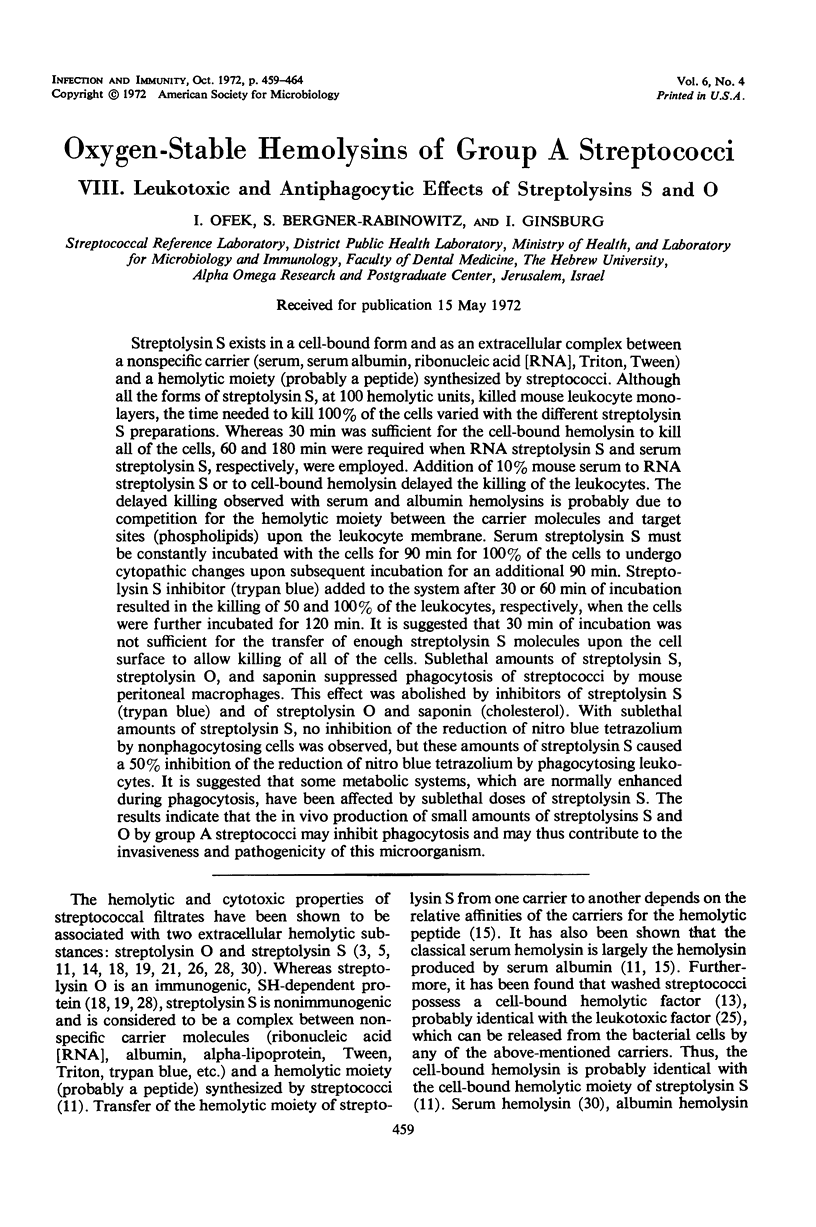

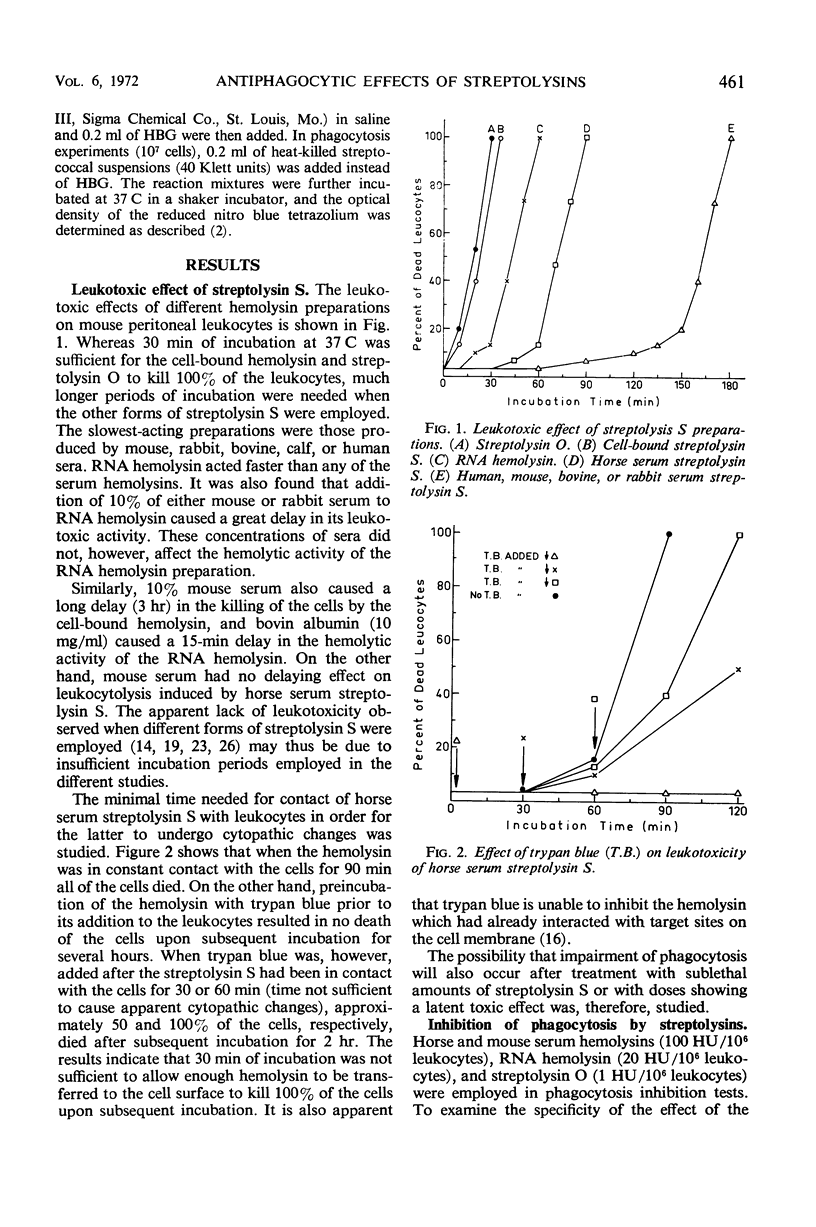
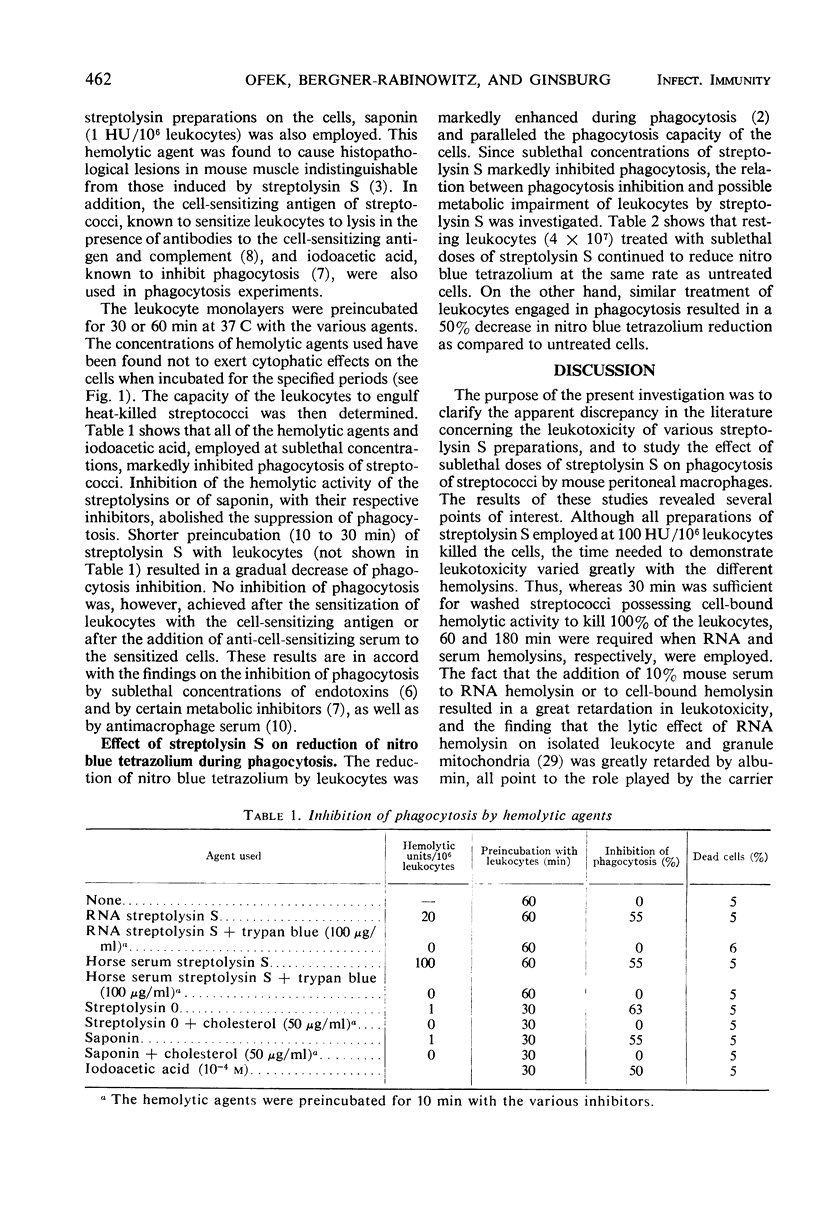
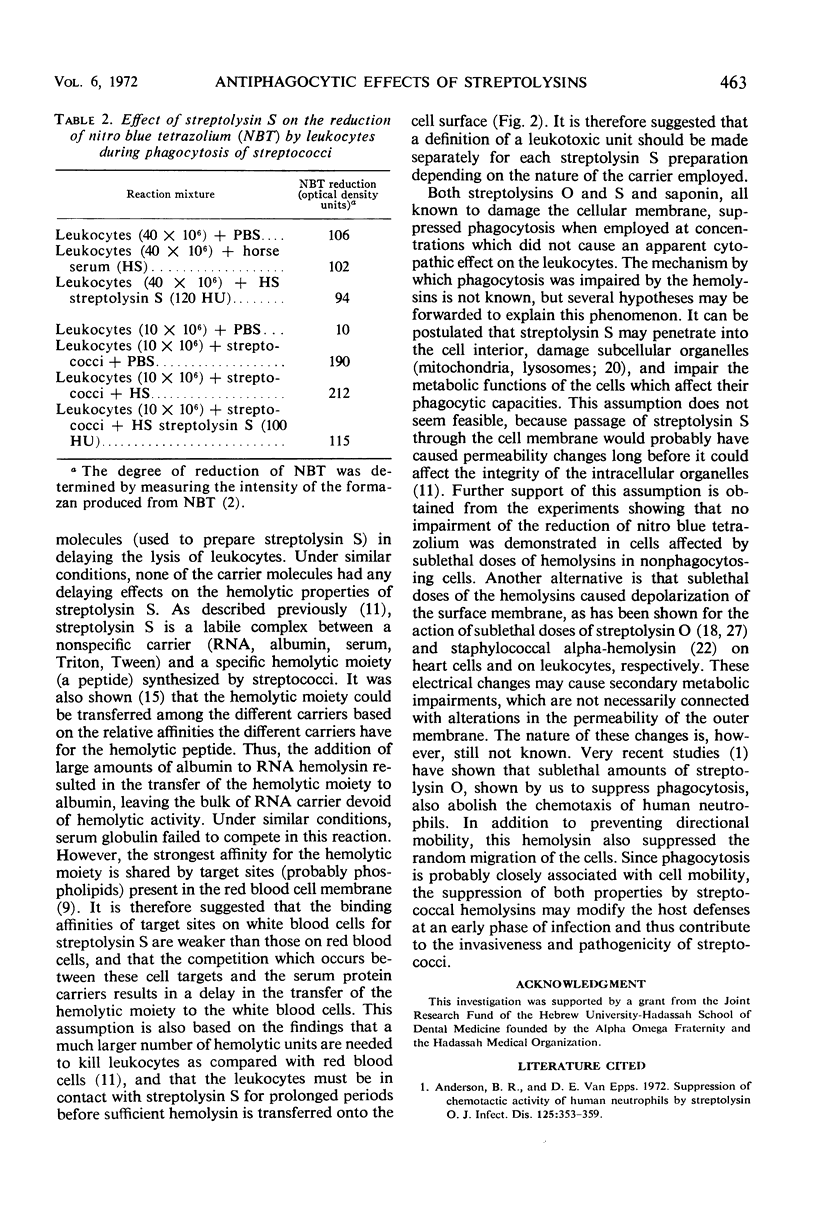
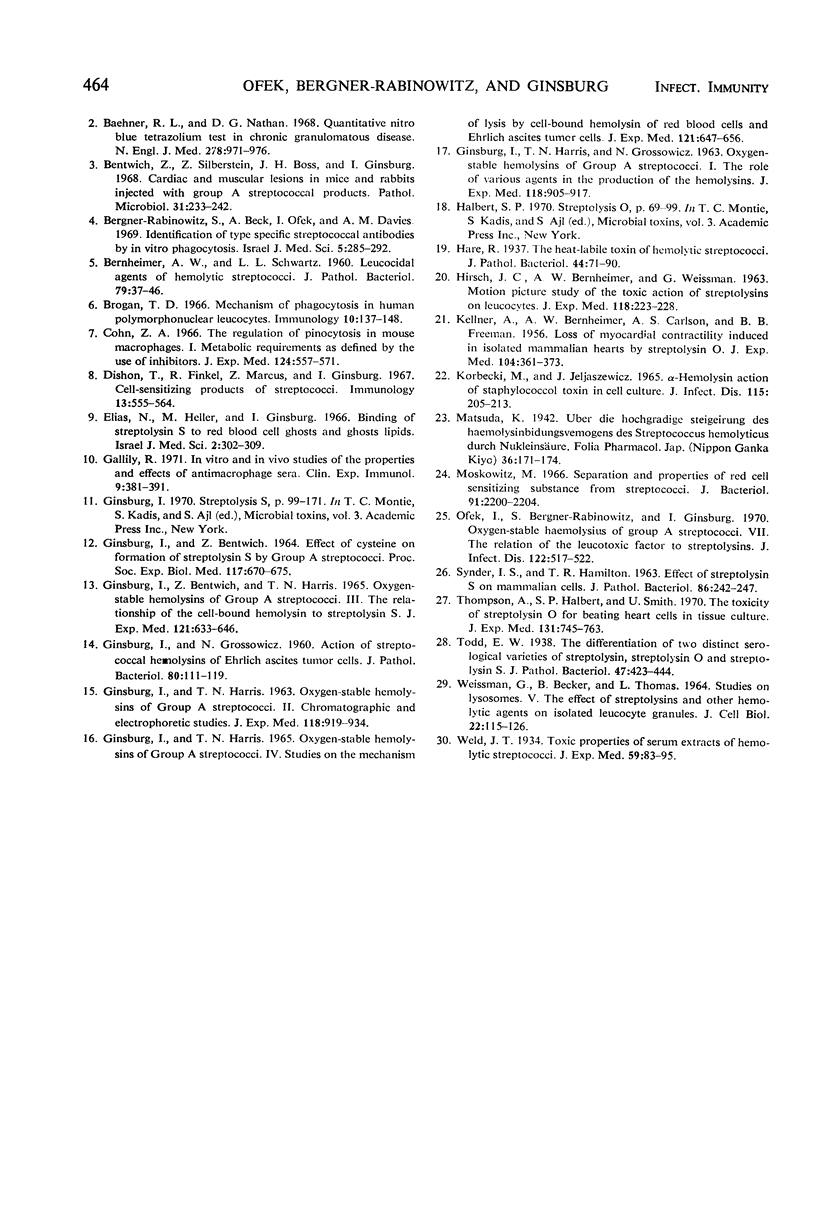
Selected References
These references are in PubMed. This may not be the complete list of references from this article.
- Andersen B. R., Van Epps D. E. Suppression of chemotatic activity of human neutrophils by streptolysin O. J Infect Dis. 1972 Apr;125(4):353–359. doi: 10.1093/infdis/125.4.353. [DOI] [PubMed] [Google Scholar]
- BERNHEIMER A. W., CARLSON A. S., FREEMAN E. B., KELLNER A. Loss of myocardial contractility induced in isolated mammalian hearts by streptolysin O. J Exp Med. 1956 Sep 1;104(3):361–373. doi: 10.1084/jem.104.3.361. [DOI] [PMC free article] [PubMed] [Google Scholar]
- BERNHEIMER A. W., SCHWARTZ L. L. Leucocidal agents of haemolytic streptococci. J Pathol Bacteriol. 1960 Jan;79:37–46. doi: 10.1002/path.1700790105. [DOI] [PubMed] [Google Scholar]
- Baehner R. L., Nathan D. G. Quantitative nitroblue tetrazolium test in chronic granulomatous disease. N Engl J Med. 1968 May 2;278(18):971–976. doi: 10.1056/NEJM196805022781801. [DOI] [PubMed] [Google Scholar]
- Bentwich Z., Silberstein Z., Boss J. H., Ginsburg I. Cardiac and muscular lesions in mice and rabbits injected with group A streptococcal products. Pathol Microbiol (Basel) 1968;31(4):233–242. doi: 10.1159/000162023. [DOI] [PubMed] [Google Scholar]
- Bergner-Rabinowitz S., Beck A., Ofek I., Davies A. M. Identification of type specific streptococcal antibodies by in vitro phagocytosis. Isr J Med Sci. 1969 May-Jun;5(3):285–292. [PubMed] [Google Scholar]
- Brogan T. D. Mechanisms of phagocytosis in human polymorphonuclear leucocytes. Immunology. 1966 Feb;10(2):137–148. [PMC free article] [PubMed] [Google Scholar]
- Cohn Z. A. The regulation of pinocytosis in mouse macrophages. I. Metabolic requirements as defined by the use of inhibitors. J Exp Med. 1966 Oct 1;124(4):557–571. doi: 10.1084/jem.124.4.557. [DOI] [PMC free article] [PubMed] [Google Scholar]
- Dishon T., Finkel R., Marcus Z., Ginsburg I. Cell-sensitizing products of streptococci. Immunology. 1967 Dec;13(6):555–564. [PMC free article] [PubMed] [Google Scholar]
- Elias N., Heller M., Ginsburg I. Binding of streptolysin S to red blood cell ghosts and ghost lipids. Isr J Med Sci. 1966 May-Jun;2(3):302–309. [PubMed] [Google Scholar]
- GINSBURG I., BENTWICH Z. EFFECT OF CYSTEINE ON FORMATION OF STREPTOLYSIN S BY GROUP A STREPTOCOCCI. Proc Soc Exp Biol Med. 1964 Dec;117:670–675. doi: 10.3181/00379727-117-29664. [DOI] [PubMed] [Google Scholar]
- GINSBURG I., BENTWICH Z., HARRIS T. N. OXYGEN-STABLE HEMOLYSINS OF GROUP A STREPTOCOCCI. 3. THE RELATIONSHIP OF THE CELL-BOUND HOMOLYSIN TO STREPTOLYSIN S. J Exp Med. 1965 Apr 1;121:633–645. doi: 10.1084/jem.121.4.633. [DOI] [PMC free article] [PubMed] [Google Scholar]
- GINSBURG I., GROSSOWICZ N. Effect of streptococcal haemolysins on Ehrlich ascites tumour cells. J Pathol Bacteriol. 1960 Jul;80:111–119. [PubMed] [Google Scholar]
- GINSBURG I., HARRIS T. N., GROSSOWICZ N. OXYGEN-STABLE HEMOLYSINS OF GROUP A STREPTOCOCCI. I. THE ROLE OF VARIOUS AGENTS IN THE PRODUCTION OF THE HEMOLYSINS. J Exp Med. 1963 Dec 1;118:905–917. doi: 10.1084/jem.118.6.905. [DOI] [PMC free article] [PubMed] [Google Scholar]
- GINSBURG I., HARRIS T. N. OXYGEN-STABLE HEMOLYSINS OF GROUP A STREPTOCCI. IV. STUDIES ON THE MECHANISM OF LYSIS BY CELL-BOUND HEMOLYSIN OF RED BLOOD CELLS AND EHRLICH ASCITES TUMOR CELLS. J Exp Med. 1965 Apr 1;121:647–656. doi: 10.1084/jem.121.4.647. [DOI] [PMC free article] [PubMed] [Google Scholar]
- GINSBURG I., HARRIS T. N. OXYGEN-STABLE HEMOLYSINS OF GROUP A STREPTOCOCCI. II. CHROMATOGRAPHIC AND ELECTROPHORETIC STUDIES. J Exp Med. 1963 Dec 1;118:919–934. doi: 10.1084/jem.118.6.919. [DOI] [PMC free article] [PubMed] [Google Scholar]
- Gallily R. In vitro and in vivo studies of the properties and effects of antimacrophage sers (AMS). Clin Exp Immunol. 1971 Sep;9(3):381–391. [PMC free article] [PubMed] [Google Scholar]
- HIRSCH J. G., BERNHEIMER A. W., WEISSMANN G. MOTION PICTURE STUDY OF THE TOXIC ACTION OF STREPTOLYSINS ON LEUCOCYTES. J Exp Med. 1963 Aug 1;118:223–228. doi: 10.1084/jem.118.2.223. [DOI] [PMC free article] [PubMed] [Google Scholar]
- KORBECKI M., JELJASZESICZ J. ACTION OF STAPHYLOCOCCAL TOXINS IN CELL CULTURES. J Infect Dis. 1965 Apr;115:205–213. doi: 10.1093/infdis/115.2.205. [DOI] [PubMed] [Google Scholar]
- Moskowitz M. Separation and properties of a red cell sensitizing substance from streptococci. J Bacteriol. 1966 Jun;91(6):2200–2204. doi: 10.1128/jb.91.6.2200-2204.1966. [DOI] [PMC free article] [PubMed] [Google Scholar]
- Ofek I., Bergner-Rabinowitz S., Ginsburg I. Oxygen-stable hemolysins of group A streptococci. VII. The relation of the leukotoxic factor to streptolysin S. J Infect Dis. 1970 Dec;122(6):517–522. doi: 10.1093/infdis/122.6.517. [DOI] [PubMed] [Google Scholar]
- SNYDER I. S., HAMILTON T. R. Effect of streptolysin S on mammalian cells. J Pathol Bacteriol. 1963 Jul;86:242–247. doi: 10.1002/path.1700860135. [DOI] [PubMed] [Google Scholar]
- Thompson A., Halbert S. P., Smith U. The toxicity of streptolysin O for beating mammalian heart cells in tissue culture. J Exp Med. 1970 Apr 1;131(4):745–763. doi: 10.1084/jem.131.4.745. [DOI] [PMC free article] [PubMed] [Google Scholar]
- WEISSMANN G., BECHER B., THOMAS L. STUDIES ON LYSOSOMES. V. THE EFFECTS OF STREPTOLYSINS AND OTHER HEMOLYTIC AGENTS ON ISOLATED LEUCOCYTE GRANULES. J Cell Biol. 1964 Jul;22:115–126. doi: 10.1083/jcb.22.1.115. [DOI] [PMC free article] [PubMed] [Google Scholar]


